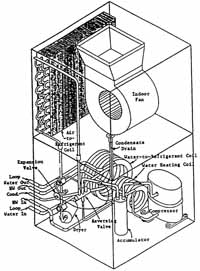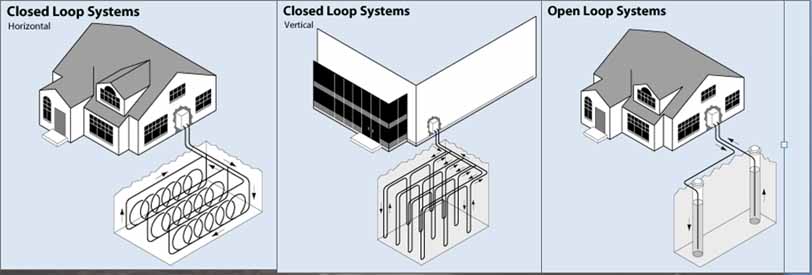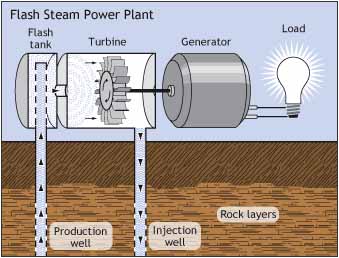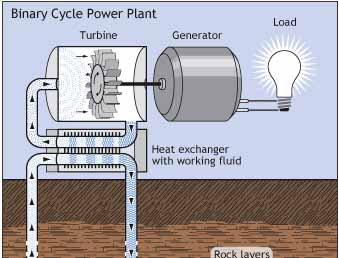
Geothermal Technologies
Geothermal Heat Pumps
Heat naturally flows from areas of higher temperature to areas of lower temperature. A heat pump is a machine that reverses this process. Geothermal heat pumps take advantage of the relatively constant year-round temperature below the earth’s surface to use the ground as a heat source and a heat sink, depending on the season. A thermal fluid, typically water, is circulated through underground pipes to a building’s heat exchange system. In the winter the heat pump extracts heat from the ground to heat the building through space heating or to heat water. In the summer, the cooler temperature of the earth can be used to extract the buildings heat and transfer it to the ground using the ground as a heat sink. The temperature between the heat source and sink is called the “lift,” and the greater the lift the more work it takes to move the heat. Former Associate Director of the Geo-Heat Center at the Oregon Institute of Technology Kevin Rafferty explains the benefits of geothermal heat pumps compared to air source heat pumps:
An air source heat pump, must remove heat from cold outside air in the winter and deliver heat to hot outside air in the summer. In contrast, the GHP [geothermal heat pump] retrieves heat from relatively warm soil (or groundwater) in the winter and delivers heat to the same relatively cool soil (or groundwater) in the summer. As a result, the geothermal heat pump, regardless of the season is almost always pumping the heat over a shorter temperature distance than the air-source heat pump. This leads to higher efficiency and lower energy use (Rafferty 1997, 2).
Thus GHPs are able to use 25% to 50% less electricity than conventional heating or cooling systems and reduce energy consumption and emissions up to 44% compared to air-source heat pumps and up to 72% compared to electric resistance heating with standard air-conditioning equipment. Geothermal heat pumps are particularly well suited to the southern United States because they are effective at cooling and dehumidifying space during the summer, maintaining about 50% relative indoor humidity (http://www.energysavers.gov/your_home/space_heating_cooling/index.cfm/mytopic=12660).
 |
| Horizontal water-to-air heat pump (Rafferty 1997) |
The basic system components of a geothermal heat pump system for heating and cooling are the earth connection subsystem, the heat pump subsystem, and the heat distribution subsystem. The most common type of heat pump is a water-to-air heat pump which includes a refrigerant-to-water heat exchanger, refrigerant piping and control valve, compressor, air coil, fan and controls. It is contained in a single unit the size of a small furnace (Rafferty 1997, 2). Geothermal heat pump systems are either open loop or closed loop. An open loop system requires the use of a water body such as a well or pond and either discharges the water after heat has been extracted or returns it to the water body. Closed systems, also called ground-coupled systems when buried underground as opposed to underwater, cycle the same fluid through the system continuously as opposed to discharging the cooled water.
Heat pump systems are also characterized by the layout of the earth connection system. This can be horizontal or vertical. The horizontal layout usually has two pipes, either with one buried at a depth of roughly 4’ and the other at 6’ or side by side at a depth of 5’. An alternative horizontal method is the SlinkyTM method which can be used to create the same volume of heat exchange in a smaller area (http://www.energysavers.gov/your_home/space_heating_cooling/index.cfm/mytopic=12650). Vertical systems use borehole wells spaced 20’ apart and typically drilled to a depth of 100-400’, but can include much deeper wells as in the case of Friends Center. Vertical systems are more efficient because the ground temperature is virtually constant at depths greater than 100’, whereas some temperature variation can take place at the shallow depths used for horizontal systems (Rafferty 1997, 6). They are also appropriate in urban areas where land is scarce.
 |
| Common layouts of geothermal heat pump earth connection subsystem. Source: U.S. Department Of Energy |
GHP systems offer many benefits beyond using less energy. The modular nature of the systems allows for design flexibility and the hardware requires less space than conventional HVAC systems. GHP systems provide effective "zone" space conditioning which allows different parts of a home to be heated or cooled to different temperatures without the blasts of cold or hot air produced by conventional air blown systems. GHP systems are long lasting and highly reliable. The earth connection subsystem often carries warranties of 25 to 50 years, and the heat pumps often last over 20 years. They are also very quiet when operating, unlike many conventional forced air systems. (http://www.energysavers.gov/your_home/space_heating_cooling/index.cfm/mytopic=12660).
Geothermal heat pumps create dynamic heat gradients radiating out from the borehole with the temperature near the borehole becoming much cooler than its original state. This drop in temperature causes heat to flow towards the borehole. Theoretical modeling indicates a steady state is achieved after approximately 10 years allowing for sustainable operation. The recovery rate approximately equals the productive life of the heat pump system, so if a system is operated for thirty years it will take approximately thirty years for the ground to obtain practical recovery (Rybach 2003, 465). This applies to heat pumps used for heating only. If the system is used for cooling, then recovery takes place yearly as the heat that is withdrawn in the winter is replaced in the summer.
Geothermal District Heating Systems (GDHS)
District heating systems use geothermal resources with low to moderate temperatures, 68°F - 302°F (20°C to 150°C). Sources tapped by U.S. systems range from 98°F – 206°F (Thorsteinsson 2008, 52). A GDHS can be either closed or open. In an open system the geothermal fluid is delivered directly to buildings. The building’s heat exchanger extracts the heat from the geothermal fluid to heat the building while isolating that fluid from the building’s system. In a closed system, geothermal water is pumped through a heat exchanger to heat city water that is piped to buildings in the district. Each building has a separate heat exchanger which transfers the heat from the district’s pipes to the building’s heating system. After the heat has been extracted from the geothermal fluid the fluid must be disposed of. This is done either by surface disposal in which the water is released into lakes, rivers, or percolation ponds, or by injection back into the geothermal resource. Although more expensive, the latter is more efficient and sustainable as it replenishes the geothermal aquifer allowing for the fluid to be reheated.
 |
| Simple schematic of a GDHS (Trexler 2008, 17) |
The injection of cooled water accelerates the depletion of the reservoir’s heat content causing increasing thermal gradients in the reservoir and a corresponding increase in conductive thermal recovery, “hence, a thermal steady state will be reached after a sufficient circulation time, which yields a practically constant production temperature; and production at that rate can be sustained” (Rybach 2007, 4). Because the rate of cooling decreases significantly over time it may take 300 years or more before a steady state is reached. Rybach reports:
Practical proof of sustainable doublet [typical district heating] system operation is provided by the operational experience with the numerous doublet installations in the Paris Basin. Most of these systems have operated since the early 1970s and, so far, no production temperature or water level drawdowns have been observed (Rybach 2007, 4).
After production ceases resource recovery for GDH systems may take 100-200 years (Ryback 2003, 465).
GDHS create significant savings to large buildings (50,000 square feet or more). Savings are produced in multiple ways. Connecting to district heating can save hundreds of thousands of dollars per year in personnel expenses as boiling room operators are not needed, and can reduce insurance costs by reducing the risk of fire. The elimination of a boiler room can free up rentable space. Many geothermal heating districts also offer chilled water for space cooling much more cheaply than using electricity for air conditioning. Retrofits also tend to be more feasible in large buildings because hot water based heating systems are more common in large buildings than in small ones (Rafferty 2003, 4).
Studies have shown that consumers tend to require a payback of three to five years before they will switch to more energy efficient technologies (Rafferty 2003, 7). For small buildings less than 10,000 square feet high retrofits costs combined with relatively low heat requirements tend to result in insufficient economic incentives to induce building owners to connect to a geothermal district heating system. Where buildings have high energy needs and use electricity or propane as heating fuel, favorable economics may occur for buildings greater than 5,000 square feet, but GDHS generally cannot compete with natural gas for heating small buildings (Rafferty 2003, 8). In the United States, most of the moderate enthalpy geothermal resources suitable for district heating occur in relatively unpopulated areas dominated by small communities of 5,000 or fewer residents where smaller buildings are the norm (Rafferty 2003, 8).
Geothermal Power Plants
There are several different types of power plant designs for using geothermal heat for electricity generation. Power generation requires high temperature resources. “Dry steam” systems were the first developed. These use steam directly from geothermal reservoir to drive a turbine. The Geysers in California is an example of a dry steam power plant. A “Flash” system, which is the most common type of power plant, requires resource temperatures of greater than 360°F (182°C). The super hot fluid is sprayed into a cold tank to cause rapid vaporization. The greater temperature difference between the fluid and the tank results in more power. In a “binary cycle” system the geothermal fluid is pumped through heat exchanger to heat a secondary (working) fluid with a much lower boiling temperature. Thus lower temperature (250°F - 360°F) geothermal resources can be used for electricity production. Because of the closed loop design binary cycle plants have virtually zero emissions (http://www1.eere.energy.gov/geothermal/powerplants.html). The final type of power plant is an “Enhanced Geothermal” or “Hot Dry Rock” system which creates a geothermal reservoir by fracturing hot dry rocks and circulating water through injection and extraction wells.
 |
 |
Source: http://www1.eere.energy.gov/geothermal/powerplants.html |
|